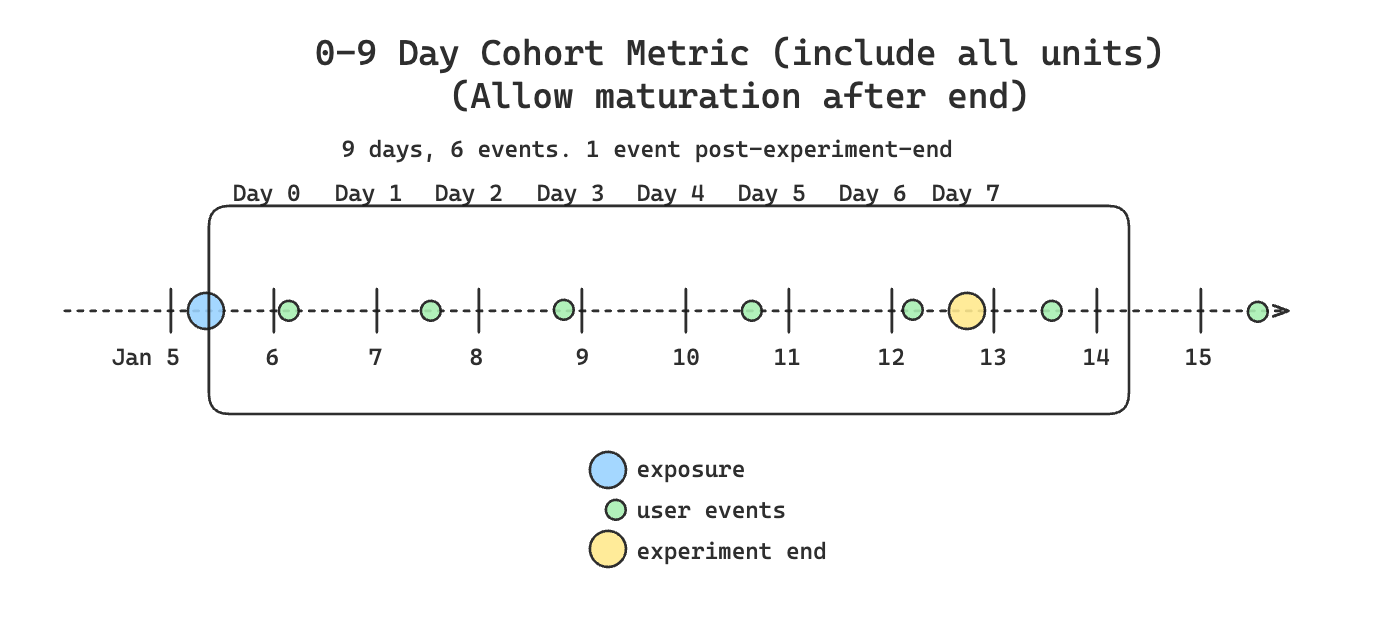- By ensuring all users have equal periods for data collection, there is an “apples to apples” comparison across user enrolled early/late in the experiment (which often corresponds to power/occasional users), and across different “time periods” that may have extrinsic factors like holidays
- If analyzing an unbounded period, experimental units’ variance in the population can increase over time - leading to scenario where error bars don’t actually converge towards 0 as the experiment is run for longer!
- This allows one to skip noisy early metrics, or focus on outcomes after users might churn - e.g. capturing “week-2 engagement” if a product has a 1-week trial period
- This can also be used to capture “one-shot retention”. Retention metrics are used to capture rolling, ongoing retention. A user metric with a window from day X to day Y is a good way to check if an experiment is causing more users to retain at least X days
- They do not capture any sort of long-term impact, or how that evolves over time. This is purely a point in time analysis and may not be appropriate for measuring complex, evolving behaviors
- They make topline impact estimates lossier and harder to trust
Basic Cohort Windows
Basic cohort windows are fairly simple. They are a filter on metric data with a time range relative to the unit’s time of exposure. For example, this cohort metric from 1 to 6 days would filter to events from 24 hours until 144 hours from when they were exposed to the experiment.This is calculated as a timestamp comparison; a unit enrolled at 12pm will have exactly 24 hours until they hit the end of a 0-1 day cohort.
2025-01-05T09:00 will include the date-based data from 2025-01-05 instead of truncating to times “after 9:00am”).
Waiting for Maturation
By default, cohort metrics can have a mix of maturation in the experimental population. For a 1-week cohort, users enrolled in the last week of the cohort will have a mix of maturities during analysis. This does yield maximal sample, but can “dilute” the analysis with partial cohort windows. To prevent this, mark the metric as needing to “Wait for cohort window to complete”. This will drop units’ metric data from analysis, and removes them from the experiment analysis population. In the examples below, one metric forces cohorts to complete. It has less units in the analysis, since many units do not have a complete window, a lower total because of the small unit count, but a higher mean since the units it does have have completed their window and have a longer data collection period on average.

Visual Examples
This is what the data collection looks like for a standard cohort metric with a 0-6 day window. Note that this collects data for 7 days - it’s 0-indexed.



Experiment-based Cohort Settings
Cohort controls are also available on experiments. This is because the relevance of these features depends on the kind of experiment being run, as discussed below.Allow post-experiment cohort data
Checking Allow Cohort Metrics to Mature After Experiment End allows metrics to be collected after the end of the experiment. This is recommended for one-time interventions, e.g. a new signup page; getting post-experiment signal from units who did get the intervention means additional statistical power.
Fixed Duration
On the Experiment Population section of the experiment setup page, there is an option for fixed-window cohorting under Configure Analysis Period with Analysis Type Fixed Duration. This only counts metrics for a certain period after experiment start. This is useful when there’s an experiment with a specific point in time, like email campaigns or other cases of fixed enrollment events.
Cohorted Duration
On the Experiment Population section of the experiment setup page, there is an option for allocation-based cohorting under Configure Analysis Period with Analysis Type Cohorted Duration. This is identical to the metric-based cohort, but applies globally to all possible metrics in the experiment analysis. This is a great way to globally add a cohort when appropriate, e.g. new user experiments.When this is used in conjunction with metric cohorts, the minimal end of the cohort window will be used.
For example, if a metric cohort is set to end at 7 days and the experiment at 10 days, 7 will be used. If the metric cohort is set to end at 7 days and the experiment at 5 days, 5 will be used.
Metric Bake Windows
In some cases, a metric in your warehouse may not be matured until a certain time period, after which you care about the daily value. Statsig provides the option to specify a bake window for your metrics. Similarly to the option above, metrics who have not reached the bake window’s end will be excluded from the numerator and denominator of the metric in the analysis. One example of a metric that may not be immediately mature is daily revenue. If a user makes a purchase but refunds it a few days later, their daily revenue may retroactively change to reflect the refund on a later date. A 28 day long refund period for users might align naturally a 28 day long bake window for revenue metrics.

